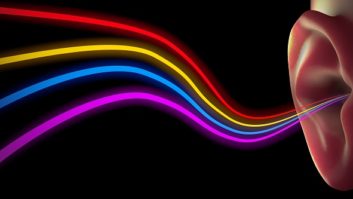Frequency Coordination for Wireless Mics
Oct 1, 2013 7:00 AM, By Kevin McNamara
Over the past few years, technology has embraced “cutting the cord.” Virtually every type of device can communicate wirelessly, either using Wi-Fi or Bluetooth. While this technology is pretty impressive, consider that wireless microphones have been around since the 1940s. By 1959, people could purchase handheld or lavalier mics.
As technology improved, most high-end wireless microphones were allowed to operate on “unused” and “white space” (or within the guard band) portions of the 698MHz to 806MHz spectrum. The frequencies were primarily used by television stations licensed to channels 52 through 69, prior to the FCC DTV conversion mandate, which required stations licensed to cease operating on these channels after Dec. 31, 2011. The FCC also banned the sale and use of wireless microphones or similar devices (wireless intercoms, ear monitors, audio instrument links and cueing equipment) intended for use in the United States in the 700MHz band in January 2010 and June 12, 2010, respectively. This allowed the FCC to repurpose the spectrum and create new blocks, some of which were auctioned and purchased by wireless carriers to operate 4th generation services such as LTE. The remaining portion was allocated for interoperable digital public safety radio systems, including the upcoming implementation of public safety LTE systems.
Wireless microphones can legally operate on a number of other frequency bands including 902MHz – 928MHz, 944MHz – 952MHz (yes, where STLs commonly operate), 2.4GHz, or even using a spread-spectrum scheme called UWB that operates in the 3GHz – 10GHz range. The problem is that these bands are commonly shared with a multitude of other devices and are subject to interference or limited in range.
To permit a more desirable spectrum for devices displaced from the 700MHz space, the Federal Communications Commission adopted rules and procedures that would authorize unlicensed television band devices (TVBDs), of which wireless microphones are included, to make use of unoccupied parts of current television channels, or white spaces. The Commission’s rules (47 C.F.R. � 15.701) currently permit unlicensed radio devices to transmit on white space in the spectrum bands used by the broadcast television service, i.e., 54-72MHz, 76-88MHz, 174-216MHz, 470-608MHz and 614-698MHz.
TVBDs would have to protect all television stations, and related operations, from any interference. To do so, TVBDs would have to regularly check TV band databases, and based on information contained there, not operate in a way that could affect television. The problem was that there was no official database available until recently.
In the implementation of a database that could manage TVBDs nationally, the FCC’s rules require that TV white space database systems protect the following radio services and receive-only operations (authorized services):
� Broadcast television stations (including full power, TV translator, low power TV, and Class A stations);
� Fixed broadcast auxiliary service (BAS) links (regular licensed and temporary);
� Receive sites (and received channels) of TV translator, low-power and Class A TV stations, and multichannel video programming distributors (MVPDs);
� Public safety and private land mobile operations;
� Offshore radio telephone service operations;
� Radio astronomy service operations at specific sites.
� Low-power auxiliary service operations (licensed and certain approved unlicensed wireless microphone venue sites). Except for MVPD receive sites, sites where licensed.
According the FCC, the database must be designed “In order to protect TV broadcast and other licensed services operating in these bands, the rules require these TV white space devices to obtain a list of channels available for their operation (i.e., in general, channels not occupied by authorized radio services) at their individual locations from a database system authorized by the Commission and to operate only on those channels. The database systems protect authorized services by preventing TV white space devices from operating on channels in which they could cause interference to the authorized services and unlicensed wireless microphones used by eligible venues.”
– continued on page 2
Frequency Coordination for Wireless Mics
Oct 1, 2013 7:00 AM, By Kevin McNamara
The FCC created a framework for the database and opened it to private sector companies who specialize in the administration of databases. The intent is to give users a variety of choice in which company to register. To initially test the system, on Sept. 19, 2012, the Office of Engineering Technology opened the registration of TVBDs operating in a limited area through certain private companies. Subsequently on Dec. 6, 2012, the OET and WTB approved two of the companies, Spectrum Bridge and Iconnectiv to provide registration and coordination services nationwide. It is interesting to note that Iconnectiv was the once esteemed research and development arm of Bell Labs. Also known as Bellcore, it was responsible for many of the telecom standards still in use today. The company was recently purchased by Ericsson.
The Spectrum Bridge Web portal (whitespaces.spectrumbridge.com/whitespaces/Home.aspx) is straightforward. You can view available white space by entering one of the following location criteria or use an interactive map: Complete address (street, city, state; Zip Code) or latitude, longitude.

The Spectrum Bridge site provides channel availability in a tabular report and several other formats.
The Web portal can also be used to register certain protected devices and services entitled to protection authorized by the FCC rules. These devices and services include: low-power auxiliary stations, including wireless microphones, Multi-Channel Video Programming Distributor (MVPD) receive sites and broadcast auxiliary links (cable headend receive sites).
It also provides apps for both Apple and Android devices, which allow you to identify local white space availability.
Iconnectiv also provides a Web portal (prism.telcordia.com/tvws/main/home/index.shtml) with the ability to view available white space locally and register protected devices. It doesn’t appear it has apps for smartphones.

The Iconnectiv white space database provides a map-based method to determine channel availability.
McNamara is president of Applied Wireless, Cape Coral, FL.
October 2013
Buying a new transmitter, inside IMG College, frequency coordination of wireless mics, on-air telephone systems, and the Radio magazine annual Salary Survey….









